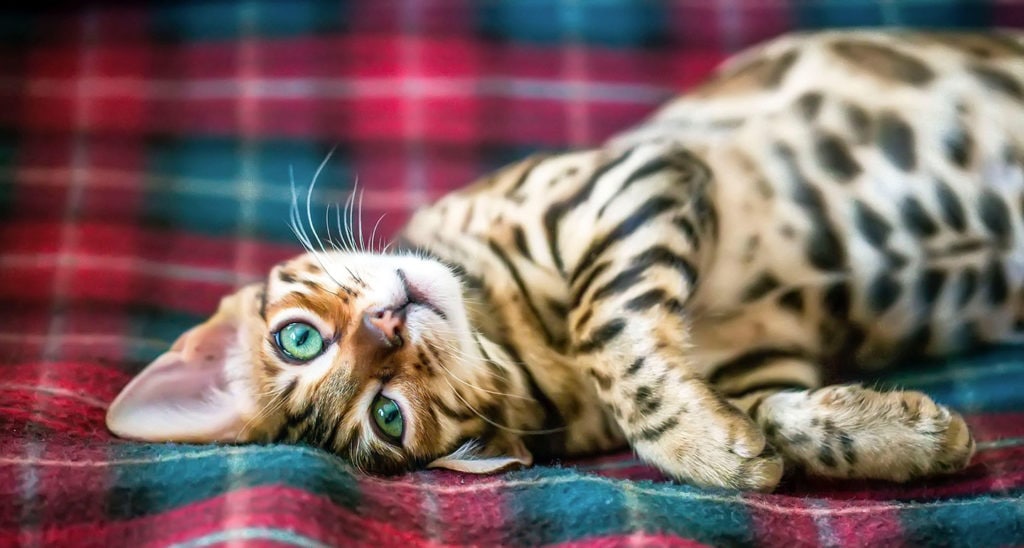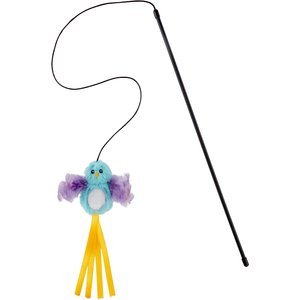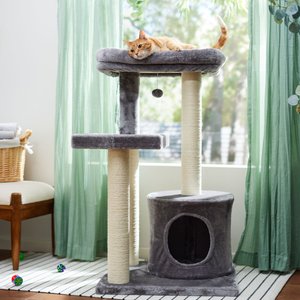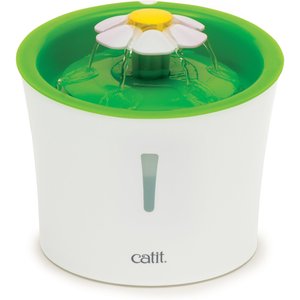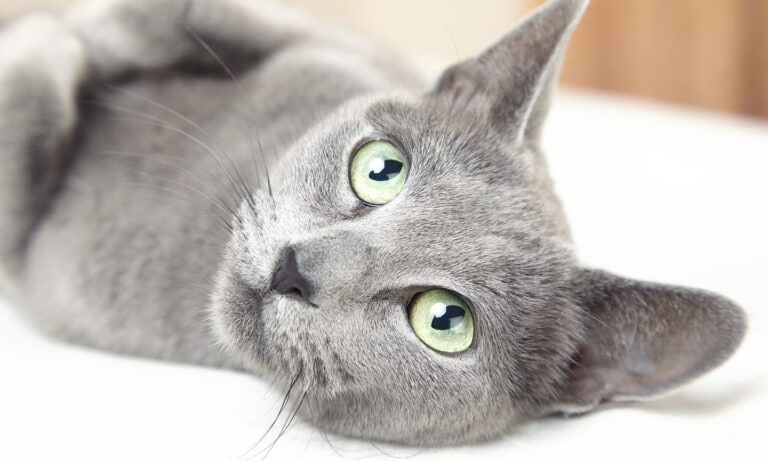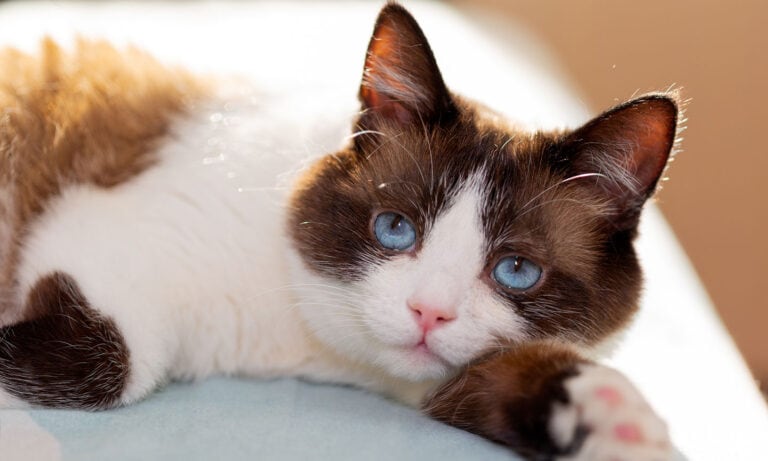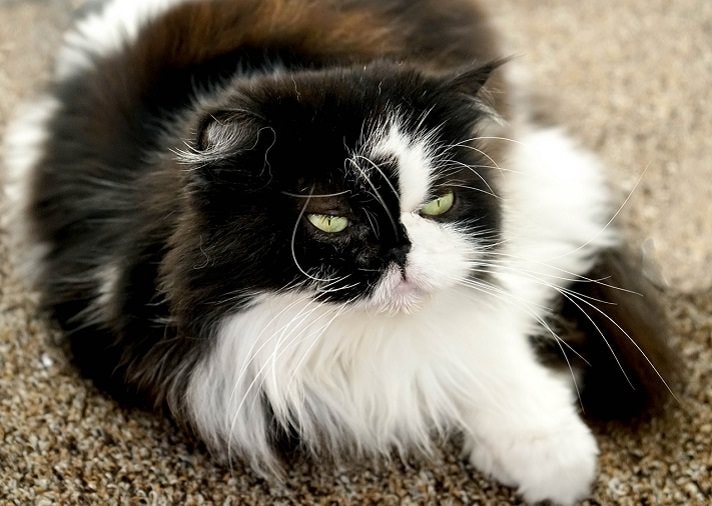In This Guide:
Bengal Cat Breed Facts
Here’s a fun fact about Bengals: Unlike most felines, many members of this breed actually love water so don’t be surprised if they want to bathe when you do.
- Weight: Males, 9–15 pounds; females, 6–12 pounds
- Length: 14–18 inches
- Lifespan: 12–20
- Coat: Both long- and short-haired varieties
- Color: With leopard-like spots and marble markings, Bengal cat colors include varying shades of buff to orange (like the brown Tabby), creams (like the Seal Lynx Point), and grays (such as the silver Tabby, seal mink Tabby, seal sepia Tabby, charcoal spotted, and charcoal marble varieties).
- Eye color: Green, yellow, gold, blue, or aqua
- Ears: Medium to small ears, with a wide base and rounded tips
Bengal Cat Characteristics
In terms of Bengal cat breed characteristics, you can expect the following:
- Energy level: high
- Health issues: medium
- Pet friendly: medium
- Social needs: medium
- Shedding level: medium
- Vocalization tendency: medium
- Grooming needs: low
Bengal Cat Breed History
The International Cat Association officially named Bengals a new breed in 1986, and today, Bengals are just bred with other Bengals—no more mixing and mingling with wild cats! And while they don’t make The Cat Fanciers’ Association’s top 15 list, they’re among the top five most popular pedigreed felines in the U.K.
If you’re considering adding one of these kitties to your family, potential pet parents can find Bengal cat breeders through The International Bengal Cat Society. But expect to cough up the bucks for this exotic-looking feline—Bengal cat prices can reach $3,000 or more. If you’d prefer to adopt, The International Bengal Cat Society also lists Bengal cat rescues and kitties who need to be rehomed.
What Does a Bengal Cat Look Like?
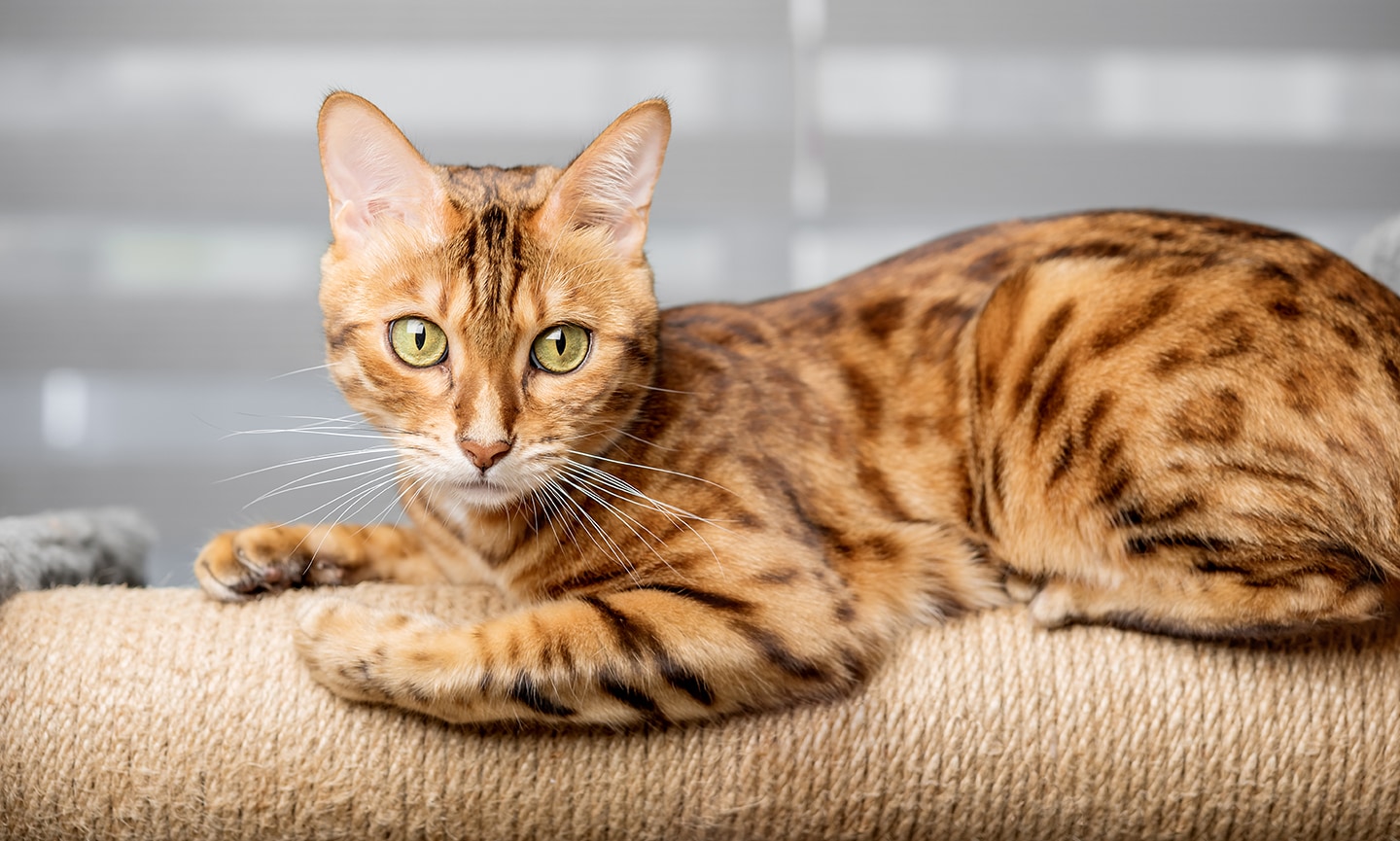
These cool cats come in a variety of colors too, but one of the most popular are the brown/black tabbies, which range in shades from light gray to goldens to mahogany, with contrasting spots in darker hues of brown or black. Bengals also come in a range of cream, from silvery white to light tan, and their spots and patterns tend to be a lighter shade of brown to a dark chocolate. But all Bengals have nearly all white fur on their bellies, which make them look like their jungle cat ancestors.
No matter what color they come in, all Bengals have luxuriously soft fur that’s made for stroking. Their eyes can be round or oval, and are usually green, yellow, or gold, though some Bengals (the lynx points) have blue or even turquoise eyes. Their faces look like wild cats, too, with wide noses and long whiskers. And if that weren’t enough, many Bengals even shimmer when the light catches the tips of their fur.
Besides beauty, Bengal cats also have strong, muscular bodies, and thick tails, the better to balance as they walk gracefully across your furniture. They’re like the Olympic athletes of the cat world—a pleasure to watch whether they’re pouncing on a toy or just strolling from one end of the room to another.
Bengal Cat Personality
Bengals often want to supervise and stay close to their people at all times. Many enjoy kids and others can enjoy the company of other cats and dogs (when they’re properly introduced, of course).
In fact, Bengal cats don’t typically do well when left alone, and can get into all kinds of trouble when these cats are bored and left to their own devices. They usually do best when they have another cat buddy to keep them company.
Bengal cats demand a lot of attention. They are usually very affectionate, but not typically a lap-sitter, although your Bengal may demand to sleep with you at night.
During awake times, Bengals prefer playing, chasing, climbing, and investigating. The Bengal loves to hunt and may bring you toys—or bugs and other critters—as feline gifts.
Overall, this is a busy cat who is incredibly active and often rambunctious. They remain athletic with kitten-like energy well into their senior years.
Bengal Cat Health Issues
Some veterinarians see Bengals as “frequent flyers,” meaning that they may be prone to a number of significant health conditions.
This list covers only a few of the problems that might be seen in this breed, so anyone considering purchasing or adopting a Bengal kitten or adult cat should discuss their health tendencies and what specifically to watch out for with their veterinarian.
Progressive Retinal Atrophy (PRA)
Progressive Retinal Atrophy (PRA) is a genetic disorder can ultimately lead to blindness in affected cats, and can begin to surface in kittens less than 2 months of age, or in adult cats as old as 12 years. Animals with the disease can be identified by an ophthalmologist, but blood and swab tests are available to determine if a particular animal is a carrier.
Unfortunately, no treatment is available for this condition.
Pyruvate Kinase Deficiency (PK)
Pyruvate Kinase Deficiency (PK) is a genetic disorder which results in hemolytic anemia, meaning that the cat’s red blood cells are destroyed before new ones are produced. Some cats may be plagued with clinical anemic symptoms, such as lethargy, while others will show no symptoms at all.
The age of onset can be as young as 8 months, or as old as 8 years. There are blood and swap tests to determine if a cat is carrying the genetic mutation causing the disease.
Feline Polyneuropathy
This is often a congenital condition in which the peripheral nerves controlling the muscles of the body have an abnormal coating, which results in poor control of the muscles. Affected animals may have trouble walking, eating, and doing other normal day-to-day activities.
The age of onset is usually between 10 and 18 months, and males are affected more commonly than females.
Non-Responsive Diarrhea and Inflammatory Bowel Disease
Cat diarrhea is very common in Bengals and the affliction has many underlying causes, often making it challenging to both diagnose and treat. In some animals, it’s determined to be caused by a chronic inflammatory intestinal condition known as inflammatory bowel disease and often requiring lifelong therapy.
Gastrointestinal lymphoma, a type of cancer that affects the intestines, is also more common in Bengal cats and can cause diarrhea and weight loss.
How To Care for a Bengal Cat
To be the best cat parent you can be, it’s important to understand how to properly care for Bengal kittens and cats. By addressing these individualized needs, you can help ensure your kitty lives their happiest and healthiest life.
Grooming
Because of their silky coats, whether long- or short-haired, Bengals do not need much extra in the way of coat care, other than routine daily brushing. Your Bengal cat's nails should be clipped regularly (once a month is usually sufficient), and ideally, you should brush your cat’s teeth daily.
Nutrition
A normal, healthy Bengal does not require anything extraordinary in the way of diet. As a rule of thumb, ensure you’re offering age-appropriate cat food to meet the nutritional requirements kittens, adult, and senior cats need, and remember to always discuss their diet with your vet.
It’s worth noting though that many Bengals do require prescription diets when they are diagnosed with one of the intestinal disorders so commonly seen in this breed.
Exercise and Play
Bengals are active, inquisitive and curious, so they do require significant interactive play. Look to wand toys, such as the Frisco® Bird Teaser with Feathers, and electronic toys, like the SmartyKat® Hot Pursuit™ Electronic Concealed Motion Cat Toy, to please their playful nature.
These smart cats can also make great trick-training felines, and many can readily learn to walk on leash and harness, play fetch, and perform obedience commands, such as sit or high-five with a paw.
Bengal Cat Behavioral Tips
Due to their frisky spirit and a love for climbing, Bengals require plenty of second-story territory, so be sure to provide tall perches and cat trees—or don’t be surprised to find your cat climbing and swinging from the drapes!
And considering many Bengals’ fondness for water, yours may join you in the shower or play with the running water while you brush your teeth. A water fountain can provide lots of kitty enjoyment, but be prepared to clean up the splatter.
They are also champion purrers, and when upset can produce a wild-sounding scream.
And while Bengals appreciate companionship, they can be extremely territorial and don’t like change. Adopt a pair of cats as kittens so they can keep each other company when you’re away, or introduce the dog to your cat as a kitten. An adult Bengal may not take as kindly to sharing you and the house with new pets.
One of the best ways to keep your Bengal happy—and prevent behavior problems—is to prevent boredom. Spend time clicker-training your cat and playing interactive games that mimic hunting to keep your Bengal cat’s brain engaged.
The Bengal is definitely a one-of-a-kind cat, and, while beautiful to look at, isn’t necessarily the right cat for every household. But should you decide this is the right cat for you, fasten your seatbelt and prepare yourself for many years of entertainment and fun!
Expert input provided by Dr. Sandra Mitchell, DVM, and Amy Shojai, CABC.
This content was medically reviewed by a veterinarian.
Read More
Share:
